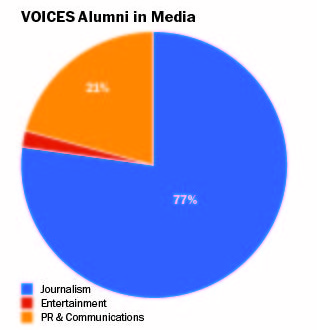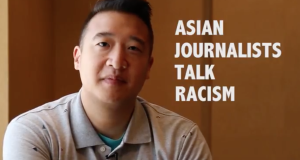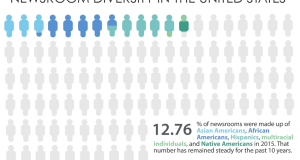Despite ongoing changes in the industry, alumni of AAJA’s VOICES program are in it for the long haul.
In a look back for the convention news project’s 25th anniversary, this year’s batch of student journalists conducted a survey and analysis of dozens of the program’s alumni.
Of the 185 surveyed, a vast majority – 79 percent – work in media. Of those, 77 percent work in journalism, with the rest employed in the communications, public relations or entertainment fields.
Among alumni working in journalism, 11 percent work in a freelance capacity and 27.4 percent have editing or executive roles. This is compared to the roughly 19 percent of minorities that have supervisory roles in print newsrooms according to statistics by the American Society of News Editors.
The second biggest employment category was academia, making up 7 percent of the employment data. Respondents report to be busy conducting research and educating students in fields including literary journalism, social welfare and geography.
Significant segments are also working in law, government and secondary education.
NEWSROOM NUMBERS
VOICES as we know it is a convergence of separate AAJA outlets. What once was a separate newspaper, radio station, TV station and website now are a single multimedia entity.
What hasn’t changed is a commitment to sending well trained journalists from diverse backgrounds into newsrooms everywhere.
When the paper was founded as AAJA-enda in 1990, newsroom minority representation was at 7.86 percent, according to the American Society of News Editors.
Now the number is close to 13 percent. The proportion of Asian American journalists in the newspaper industry hovers around 2.84 percent.
Mekhalo Medina, president of National Association of Hispanic Journalists, said a growing realization of the importance of newsroom representation is coming at the executive level.
“When I think of diversity in 2015, I don’t think of it as diversity, I think of it as reality,” Medina said. “If you look at key media companies, KPCC and Buzzfeed, they’ve all made the change to a diverse newsroom as a way to reach out to an increasingly broad audience, and also it just makes business sense.”
Growth and development of the AAJA VOICES program is indicative of a general trend of rising newsroom diversity, but one that is threatened by declining media industry opportunities.
While there’s reason to be optimistic about that level of improvement, the industry itself shows a decline in total employment, meaning minority journalists compete for fewer jobs.
Minority staff members, who are often among the most junior members of the newsroom, according to ASNE studies, are more susceptible to budget cutbacks and layoffs.
Bob Butler, president of the National Association of Black Journalists, said despite a steady percentage increase of employed minority journalists in the intervening decades, the smaller number of jobs as a whole means that the number of minority journalists finding employment hasn’t made the gains as the numbers suggest.
“We’re finding that even in states with a lot of diversity in population, we don’t have a lot of diversity in newsroom management,” Butler said. “The big issue is that the people making hiring decisions want more diversity, but don’t know how to achieve it.”
Statistics collected in 2014 by the Radio Television Digital News Association found that minorities make up less than 10 percent of managers at radio or television stations. In print newsrooms, the number is even lower, with less than 3 percent of those in “supervisory roles” of minority descent, according to ASNE.
LOOKING AHEAD
Leaders in journalism diversity and advocacy all agree on at least one part of the solution: helping journalists to develop digital and technological storytelling skills.
To that end VOICES has stepped up to the plate, with mentors and editors developing data analysis and graphic tools that have become industry standards.
“A lot of the students have kind of that interest and try to find stories that lend itself more to data analysis and opportunity for data,” said Andrew Tran, data editor for The Connecticut Mirror and a VOICES mentor. “It’s become easier now for a lot of reporters to take what they see on their spreadsheets and visualize it.”
Still, experts in journalism say in order to build minority representation, a number of tactics will have to be used, including greater connectivity with media industry executives and a realistic picture of how to prepare people to find work in the industry.
“The solution is really multi-pronged,” said AAJA President Paul Cheung. “We need to keep asking the question of, ‘How do we work with media partners to keep diversity at the front of their minds?’”
 VOICES Publishing from the AAJA National Convention
VOICES Publishing from the AAJA National Convention








